People often ask, “Should I visit Lisbon or Porto? If you can make the time, you should visit Lisbon and Porto in 2022! They are both beautiful cities and rich in history.
Below are some of the top attractions in each city, different tours available in Porto, how to get to Porto from Lisbon, and various package trips between the two cities.
Lisbon Highlights
The castle
The most visited attraction in Lisbon is the Castelo São Jorge.
There has been a settlement on the highest land in the area since the era before Christ.
The Muslem Moors took the vantage point in the eighth century, fortified the hill, and held it until Afonso Henrique and his Christian knights re-captured the castle in 1147.
Belém neighborhood
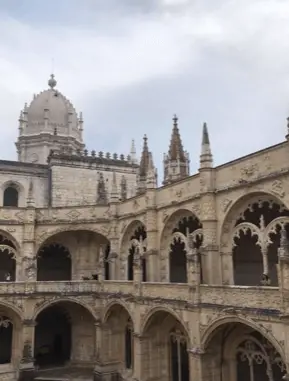
Lisbon’s Belém neighborhood has several points of interest, two of which are UNESCO world heritage sites.
The Jerónimos Monastery (Mosteiro dos Jerónimos) opened in 1495 on the site where Vasco da Gama prayed prior to his voyages.
Vasco da Gama and national poet Luis de Camōes are buried in the monastery.
The monastery itself and the chapel are stunning examples of Manueline architecture.
Across the street from the monastery, you will find the Padrão dos Descobrimentos (Monument to the Discoveries) which celebrates the Portuguese explorers.
The monument resembles the bow of a Portuguese sailing caravel, with Henry the Navigator in the front, leading the way to the open seas.
He is followed by an assortment of famous sailors, mapmakers, scientists, poets, and artists.
On the ground in front of the monument is a map and compass depicting the Portuguese colonies.
This mosaic was a gift to Portugal from the government of South Africa.
Moving west from the monument (away from the bridge,) you will see the beautiful Torre de Belém (the Belém Tower).
The tower has been standing guard over Lisbon since 1514.
Both the tower and the Castelo de São Jorge are fantastic locations to watch the sunset.
The light and the views
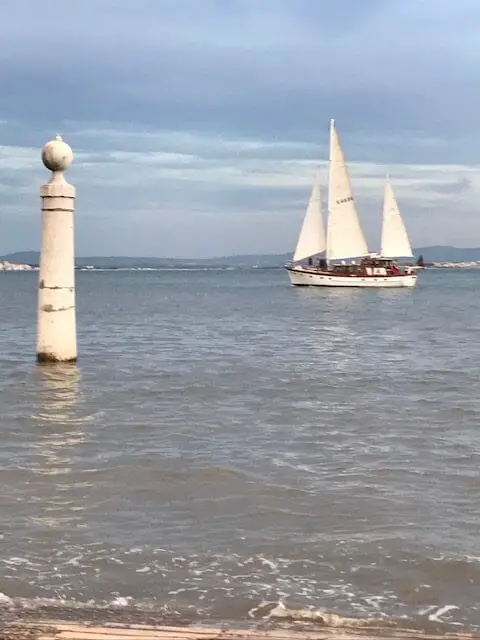
Lisbon is famous for its light and its scenic viewpoints.
The sunlight reflects off of the river and the white houses with terra cotta roofs.
The city was built on and around seven hills, so there is no shortage of miradouros or scenic viewpoints. Probably many more than you will have time to visit.
Lisbon’s medieval architecture
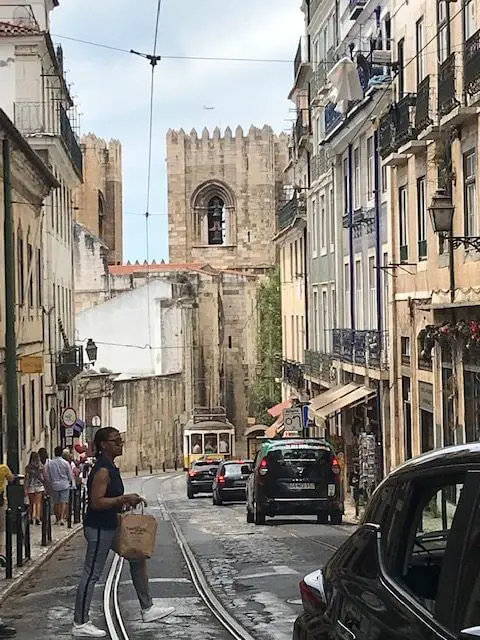
One of the great things about Lisbon is that it has a number of very old buildings, particularly churches.
The Sé de Lisboa Cathedral was built in 1147. It is Lisbon’s oldest and most important church.
The Christians built it on top of the site of a former Muslem mosque.
Convento do Carmo is another stunning church in Lisbon.
On November 1, 1755, Lisbon was hit by the most devastating earthquake to ever hit Europe.
It was noon on a Sunday (All Souls’ Day), and the church was full.
The earthquake brought the roof down on those inside, and more than 30,000 died across Lisbon.
Lisbon’s downtown was quickly rebuilt, but those in charge decided to leave the remains of the church as-is, as a reminder of the tragedy that had occurred.
Another fantastic old church (and there are several more) is inside the National Tile Museum (El Museu Nacional do Azulejo). The tile museum has examples of all styles of the blue and white tile mosaics that Portugal is famous for.
The oldest buildings you can still see in Lisbon is my article describing Lisbon’s oldest public buildings.
Modern architecture
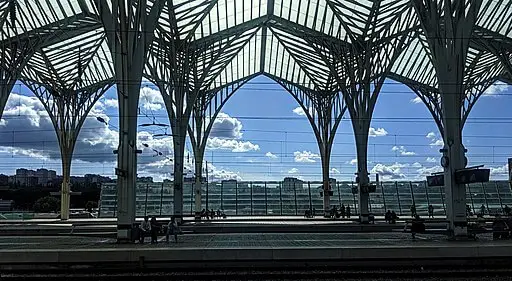
In addition to medieval architecture, Lisbon also has a few examples of fantastic modern architecture.
In particular, the Parque das Naçōes campus was built in 1998 for the World’s Fair’s Expo 98 and has several interesting contemporary buildings.
Among its most interesting buildings is the Lisbon Oceanarium.
The Lisbon Oceanarium somewhat resembles an aircraft carrier and has interesting water features. It is also Europe’s largest aquarium. For more information on Lisbon’s modern architecture, see my article, Modern and contemporary architecture in the old city of Lisbon
Food and drinks
Lisbon (all of Portugal, really) is known for having great, fresh seafood. The country has relied on the ocean for centuries.
Lisbon is home to the pastel de nata, a custard pastry that you must try.
It was invented by the monks at the Jerónimos Monastery centuries ago.
Eventually, the monks sold the recipe to a private bakery in Belém.
If they come from this bakery, they are known as Pastéis de Belém.
If sold elsewhere, in any other bakery in the city, they are called pastéis de nata.
Another item you should sample in Lisbon is Ginjinha.
Ginja or Ginjinha is a brandy-like, sweet cinnamon shot made with ginja cherries.
It has been available in Lisbon since 1840.
For a more complete list of all of your options in Lisbon, take a look at my article 205 Things to do in Lisbon – The Ultimate Guide
Lodging in Lisbon
For more information on where to stay in Lisbon, you can learn more with my articles, Hotels located near metro stations in Lisbon ,
(Updated) Lisbon’s most interesting hotels (truly unique lodging in Lisbon)
or Fun in the sun – 12 Lisbon hotels with rooftop pools .
Porto Highlights
São Bento Train Station
Praça de Almeida Garrett
The São Bento Railway station In the historic center of Porto is surely one of the most beautiful train stations in the world.
Construction on the building started in 1904.
The stunning blue and white azulejo tiles were designed and painted by Jorge Colaço.
The murals show scenes from Portugal’s history and represent people from the different regions of the country.
Approximately 20,000 tiles were placed in the train station by 1916.
Visitors coming from Lisbon do not arrive at São Bento station but instead at the Campanhã train station.
All trains leaving São Bento will make their first stop at the Campanhã station.
São Bento is on the Porto metro D line or yellow line.
Ponte Dom Luís I
Ponte Dom Luís I – Luís I Bridge is a double-deck metal arch bridge that crosses the Douro River, linking Porto to Vila Nova de Gaia.
The bridge spans 564 feet.
Gustave Eiffel proposed a single deck bridge in 1879, but the city rejected his proposal and a competition for designs was held in 1880.
A Belgian company won the competition.
On November 1, 1886 the bridge was opened.
In 2003 the upper deck was closed to car traffic, and in 2005 it began to carry metro trams for the Porto yellow line.
Torre de Clerigos
Rua de São Filipe de Nery, Porto
The church itself was built between 1732 and 1750.
Construction on the tower started in 1754 and was completed in 1763.
Italian Nicolau Nasoni designed both the church and the bell tower., as well as the Porto Cathedral.
When it was built the tower was the tallest building in Portugal.
It measures 76 m tall, has 230 steps, and is six stories.
Visitors can climb to the top for panoramic views of the city.
Catedral Sé do Porto
Built on the highest ground in the city, Sé do Porto is also the oldest building in Porto.
Construction on the cathedral started in the twelfth century and continued until 1737.
As a result, it contains a mix of different architectural styles.
On the cathedral square you can find an alley which goes downhill, winding here and there through a beautiful medieval neighborhood.
You can follow it down to sea level – to the Cais da Ribeira
Cais da Ribeira
Cais da Ribeira is the Porto Waterfront.
It is probably one of Europe’s most beautiful neighborhoods, with its colorful multi-story townhouses.
It has tons of bars and restaurants.
Also, make sure to explore the alleys and lanes behind the first row of houses on the waterfront.
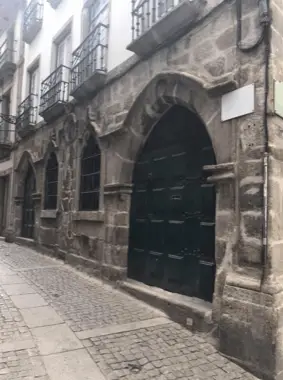
Livraria Lello – The Lello Bookstore
Rua Carmelitas 144, Porto
The Lello bookstore is one of the oldest bookstores in Portugal, and is frequently named as one of the top four most beautiful bookstores in the world.
It is also hugely popular because Harry Potter creator JK Rowling lived in Porto and is said to have been inspired by the red staircase in Livraria Lello.
José Lello began selling books with his brother in 1881. They moved their operation to the current location in 1906.
Vila Nova de Gaia
Vila Nova de Gaia is the town across from Porto on the south bank of the Douro River.
186,000 people live in Vila Nova de Gaia.
You can either walk across the top deck of the bridge, or take the metro.
Douro River Cruise

As you come down to the riverside, the first thing you will encounter are many businesses selling cruises up the Douro River.
It is absolutely worth taking the time to do this, whether you book online or in-person at one of these shops or kiosks.
For roughly 50 euros, you can find a boat that will serve lunch and wine and provide a bus ride back to Porto at dusk.
Not having a car is not a problem, you just have to make time to enjoy the trip – which might take most of the day.
Douro Cruise Providers
Living Tours Portugal’s Oporto Six Bridges Tour
An ideal boat ride on the Douro River for those who aren’t spending much time in Porto.
You get to see the six bridges from the water on this fifty-minute cruise. $17.96 per person
Tripadvisor | Oporto Six Bridges Cruise provided by Living Tours Portugal | Porto, Porto District
Get Your Guide
Three-hour private cruise of the Douro on a catamaran, for up to four people. $316 per group.
Porto: Sail the Douro River Private 3-Hour Cruise | GetYourGuide
Get Your Guide also offers a nine-hour group tour with hotel pickup with lunch and a river cruise for $105.
Full-Day Douro Wine Tour with Lunch and River Cruise | GetYourGuide
Douro Valley Tour with Visit to two vineyards, river cruise, and lunch at a winery
After being picked up at your hotel, you explore the Douro by minivan, then cruise the Douro River, enjoy a four-course meal and wine pairing, and stop at two vineyards where you will sample a variety of red and white wines.
Port Houses
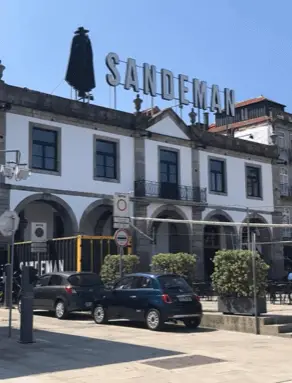
The other thing you will very quickly notice is that the Vila Nova de Gaia riverfront is mostly taken up by Port Producers, with their warehouses, tasting rooms, and restaurants with terraces.
Sitting on the patio of one of these Port cellars, enjoying the sunshine and the river, sampling the rubys, and tawnys, and reds of each brand is an awesome way to spend an afternoon!
Francesinha and Port Wine
The Francesinha is a loaded ham sandwich that began in Porto.
“The little Frenchie” is kind of like a croque monsieur, and was invented in 1910 by a French chef who moved to Porto.
A Francesinha usually has ham, but can come with several meats, and is usually finished with cheese and a beer and tomato sauce, which may or may not be spicy.
It is served with chips or french fries.
What O Porto is really famous for is the Douro Valley’s port wines.
Port is a wine that has been fortified with brandy, therefore it is a little stronger than the typical wine.
The grapes are grown on steep hills along the Douro River.
After the grapes ferment and are fortified, the oak barrels are shipped to the cooler climate of Porto, where they mature and await international shipping.
How to get from Lisbon to Porto
Getting from Lisbon to Porto by train
Comboios Portugal is the national train service.
The fastest train from Lisbon to Portugal is the Alfa Pendular.
Trains leave Lisbon roughly every hour.
You can catch a train at either the Oriente Station or the Santa Apalônia Station.
You will arrive in Porto at the Campanhä Station, and a connection to the more central São Bento station is included in the price of your ticket.
From city to city the trip takes about three hours. Tickets start at 15 euros.
Flying from Lisbon to Porto
TAP Portugal has flights from Lisbon to Porto.
The flight lasts one hour.
Round trip tickets are currently at $50.
Both Lisbon and Porto airports have metro stations that offer easy connections to the city center at a minimal cost.
Driving from Lisbon to Porto
You can drive the 186 mile trip between cities in roughly three hours if you don’t make stops.
You might also consider stopping in one of the historic towns along the way Óbidos, Fátima, Tomar, or Coimbra, or one of the beach resorts such as Ericeira, Nazaré, or Aveiro.
Buses from Lisbon to Porto
Bus company https://rede-expressos.pt/en goes from Lisbon to Porto.
The trip takes 3.5 hours and normally costs 19 euros. Even cheaper tickets can be purchased in advance.
The bus leaves Lisbon from Oriente Station (red line).
Tours and Packages from Lisbon to Porto
If you do not want to deal with the logistics of moving from Lisbon to Porto, and you would prefer to hire a professional guide to take you around, there are several options available.
You could choose a guided day trip from Lisbon, or you could opt for an all-inclusive week-long tour.
Viator Porto Full day trip from Lisbon
Starting at $312 per person.
Private driver with hotel pickup and drop-off.
The trip is approximately 10 hours.
Departure time from Lisbon is 8 am.
Stops at Livraria Lello, Torre dos Clerigos, Porto Cathedral, Sao Bento Railway Station, Taylor’s Port, Pass by Ponte Dom Luís I, Cais da Ribeira, Douro River, Gold Compass.
Food and Drinks are not included.
Porto Full Day Trip – Private Tour from Lisbon 2021 (viator.com)
YTours Portugal Bus Tour from Lisbon
11 -12 hour trip for $178 per person
Van GO Tourism Porto Private Tour from Lisbon
6+ hour trip for $300 per adult.
Wine-tasting aboard a boat is included.
Tripadvisor | Porto Private Tour from Lisbon provided by Van GO Tourism | Lisbon District
Knight Riders Tourism Private Porto from Lisbon with Portuguese lunch and Porto wine tasting
$272.65 per person day – trip from Lisbon to Portugal.
Transport by air-conditioned minivan.
Hotel pickup and drop-off are included.
The ten-hour tour departs from Lisbon at 7 am.
Kensington Tours Portugal Signature Tour 9 Days
Including the Algarve, Lisbon, and Porto
Ballpark estimate is $6228. Contact for a clearer estimate.
Portugal Signature | Portugal Tours & Luxury Travel (kensingtontours.com)
Not Lisbon OR Porto, Vacation in Lisbon AND Port0
If you are coming to Portugal, you should make time to see both Lisbon and Porto.
With TAP Air Portugal, you can even fly into one city and out of the other.
Neither city requires that you rent a car. They are both extremely walkable (in spite of the hills), and have excellent public transportation systems.
If you are traveling light, it is no problem to walk out of the airport, into the subway, and be in the historic district in a few minutes.
If I had only seven days in Portugal, I would spend four full days in Lisbon, on the fifth day take the train to Porto, and then leave from Porto.
I would prefer to spend more time in each city, if I had it.
Also, with more time, I would also look into visiting some of the beach towns such as Ericeira How do you pronounce Ericeira? And is Ericeira worth visiting? or Nazaré Nazaré, Portugal – Biggest waves in the world, less than two hours from Lisbon.
Or maybe spend time on the beaches near Lisbon in Cascais, Estoril, or Costa da Caparica. See my article How to use public transportation to get to Lisbon’s beaches and Hotels, hostels, and houseboats on the Lisbon, Estoril, Cascais coast
Also, everyone who visits Portugal should spend a day or two in Sintra. How to plan a day trip or overnight trip to Sintra from Lisbon
I am not affiliated with any business mentioned in this article. Thanks for reading!